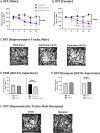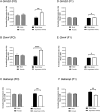Transgenerational transmission of aspartame-induced anxiety and changes in glutamate-GABA signaling and gene expression in the amygdala
- PMID: 36459641
- PMCID: PMC9894161
- DOI: 10.1073/pnas.2213120119
Transgenerational transmission of aspartame-induced anxiety and changes in glutamate-GABA signaling and gene expression in the amygdala
Abstract
We report the effects of aspartame on anxiety-like behavior, neurotransmitter signaling and gene expression in the amygdala, a brain region associated with the regulation of anxiety and fear responses. C57BL/6 mice consumed drinking water containing 0.015% or 0.03% aspartame, a dose equivalent of 8 to 15% of the FDA recommended maximum human daily intake, or plain drinking water. Robust anxiety-like behavior (evaluated using open field test and elevated zero maze) was observed in male and female mice consuming the aspartame-containing water. Diazepam, an allosteric modulator of the GABA-A receptor, alleviated the anxiety-like behavior. RNA sequencing of the amygdala followed by KEGG biological pathway analysis of differentially expressed genes showed glutamatergic and GABAergic synapse pathways as significantly enriched. Quantitative PCR showed upregulation of mRNA for the glutamate NMDA receptor subunit 2D (Grin2d) and metabotropic receptor 4 (Grm4) and downregulation of the GABA-A receptor associated protein (Gabarap) mRNA. Thus, taken together, our diazepam and gene expression data show that aspartame consumption shifted the excitation-inhibition equilibrium in the amygdala toward excitation. Even more strikingly, the anxiety-like behavior, its response to diazepam, and changes in amygdala gene expression were transmitted to male and female offspring in two generations descending from the aspartame-exposed males. Extrapolation of the findings to humans suggests that aspartame consumption at doses below the FDA recommended maximum daily intake may produce neurobehavioral changes in aspartame-consuming individuals and their descendants. Thus, human population at risk of aspartame's potential mental health effects may be larger than current expectations, which only include aspartame-consuming individuals.
Keywords: artificial sweetener; emotional behavior; intergenerational transmission.
Conflict of interest statement
The authors declare no competing interest.
Figures




Comment in
-
Concern over differences between experimental design and data analyses in Jones et al.Proc Natl Acad Sci U S A. 2023 Jun 13;120(24):e2302944120. doi: 10.1073/pnas.2302944120. Epub 2023 Jun 5. Proc Natl Acad Sci U S A. 2023. PMID: 37276402 Free PMC article. No abstract available.
Similar articles
-
In vivo knockdown of GAD67 in the amygdala disrupts fear extinction and the anxiolytic-like effect of diazepam in mice.Transl Psychiatry. 2012 Nov 13;2(11):e181. doi: 10.1038/tp.2012.101. Transl Psychiatry. 2012. PMID: 23149445 Free PMC article.
-
Amantadine exerts anxiolytic like effect in mice: Evidences for the involvement of nitrergic and GABAergic signaling pathways.Behav Brain Res. 2020 Feb 17;380:112432. doi: 10.1016/j.bbr.2019.112432. Epub 2019 Dec 12. Behav Brain Res. 2020. PMID: 31838141
-
Increased anxiety and altered responses to anxiolytics in mice deficient in the 65-kDa isoform of glutamic acid decarboxylase.Proc Natl Acad Sci U S A. 1999 Feb 16;96(4):1698-703. doi: 10.1073/pnas.96.4.1698. Proc Natl Acad Sci U S A. 1999. PMID: 9990087 Free PMC article.
-
Training-induced changes in the expression of GABAA-associated genes in the amygdala after the acquisition and extinction of Pavlovian fear.Eur J Neurosci. 2007 Dec;26(12):3631-44. doi: 10.1111/j.1460-9568.2007.05970.x. Eur J Neurosci. 2007. PMID: 18088283 Free PMC article.
-
Neurosteroid biosynthesis regulates sexually dimorphic fear and aggressive behavior in mice.Neurochem Res. 2008 Oct;33(10):1990-2007. doi: 10.1007/s11064-008-9718-5. Epub 2008 May 13. Neurochem Res. 2008. PMID: 18473173 Review.
Cited by
-
Jiannao pills mitigate chronic restraint stress-induced anxiety in mice through the regulation of intestinal microflora.Am J Transl Res. 2024 Sep 15;16(9):4549-4563. doi: 10.62347/GEEW4432. eCollection 2024. Am J Transl Res. 2024. PMID: 39398613 Free PMC article.
-
Behavioral, neurotransmitter and transcriptomic analyses in male and female Fmr1 KO mice.Front Behav Neurosci. 2024 Sep 6;18:1458502. doi: 10.3389/fnbeh.2024.1458502. eCollection 2024. Front Behav Neurosci. 2024. PMID: 39308631 Free PMC article.
-
Frontiers and hotspots in anxiety disorders: A bibliometric analysis from 2004 to 2024.Heliyon. 2024 Aug 5;10(16):e35701. doi: 10.1016/j.heliyon.2024.e35701. eCollection 2024 Aug 30. Heliyon. 2024. PMID: 39220967 Free PMC article.
-
Isoflurane anesthesia decreases excitability of inhibitory neurons in the basolateral amygdala leading to anxiety‑like behavior in aged mice.Exp Ther Med. 2024 Aug 13;28(4):399. doi: 10.3892/etm.2024.12688. eCollection 2024 Oct. Exp Ther Med. 2024. PMID: 39171147 Free PMC article.
-
The influence of exercise intensity on comorbid anxious behavior in psychiatric conditions.J Physiol Sci. 2024 Aug 2;74(1):39. doi: 10.1186/s12576-024-00930-7. J Physiol Sci. 2024. PMID: 39090547 Free PMC article.
References
-
- FDA, Aspartame, commissioner’s final decision. ed D. o. H. a. H. Services (Federal Register, Washington, D.C., 1981), 46 pp. 3824–38308.
-
- Singh R., Singh A., Sachan S. “Enzymes Used in the Food Industry: Friends or Foes?” in Enzymes in Food Biotechnology: Production, Applications, and Future Prospects, Kuddus M. Ed. (Academic Press, London, U.K., 2019), chap. 48, pp. 827–843, 10.1016/B978-0-12-813280-7.09993-X. - DOI
-
- Yokogoshi H., Roberts C. H., Caballero B., Wurtman R. J., Effects of aspartame and glucose administration on brain and plasma levels of large neutral amino acids and brain 5-hydroxyindoles. Am. J. Clin. Nutr. 40, 1–7 (1984). - PubMed
-
- Torii K., Mimura T., Takasaki Y., Ichimura M., Dietary aspartame with protein on plasma and brain amino acids, brain monoamines and behavior in rats. Physiol. Behav. 36, 765–771 (1986). - PubMed
-
- Yokogoshi H., Wurtman R. J., Acute effects of oral or parenteral aspartame on catecholamine metabolism in various regions of rat brain. J. nutrition. 116, 356–364 (1986). - PubMed
Publication types
MeSH terms
Substances
LinkOut - more resources
Full Text Sources
Medical


